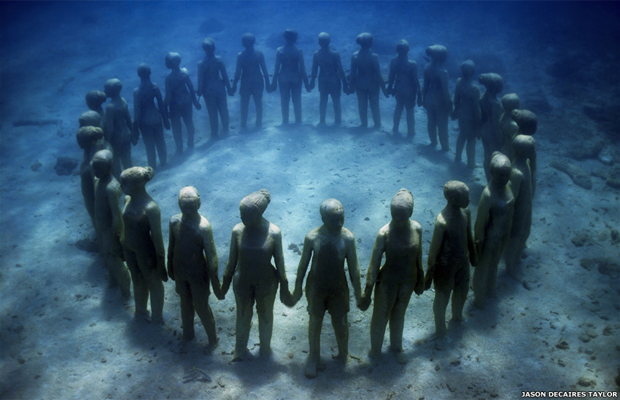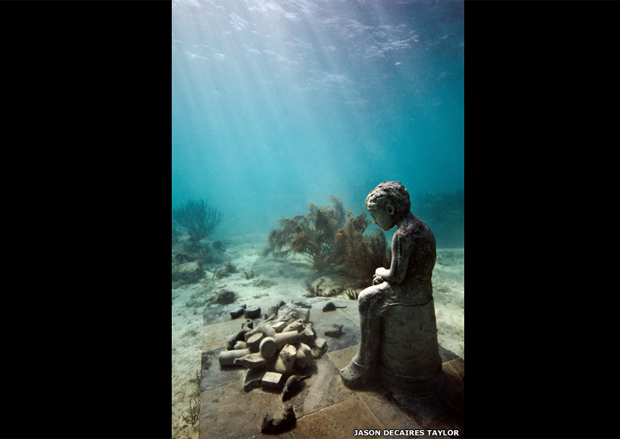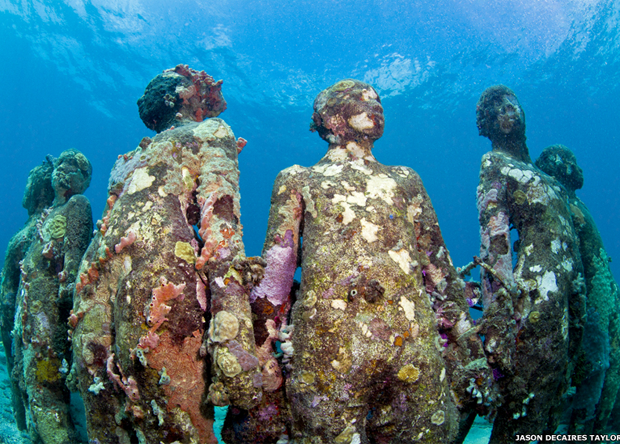|
Off the coast of Isla de Mujeres near the Mexican
city of Cancun a hidden world lies buried 28ft beneath the ocean waves.
The Cancun Underwater Museum, also known as MUSA, is a collection of
sculptures deliberately placed on the ocean floor by English artist
Jason deCaires Taylor.
Each of the 460 statues in the underwater exhibition are made from
PH-neutral marine concrete designed to encourage marine plants to grow
and attract fish to the region, and the museum was set up to draw
tourists away from nearby coral reefs.
|
|
 |
|
According to the tourist board, around 300,000 people visit the area
each year, but snorkeling groups have been known to cause damage to
marine life, for example, by kicking them as they swim past.
Jaime Gonzalez, director of the West Coast National Park, said: 'If they
swim near the corals, the divers with little experience might kick them
with a fin or hit them with the oxygen tank. Before it was declared a
park, the tourists even climbed up the corals and walked on top of them,
breaking and shattering them.'
DeCaires-Taylor added: 'Something had to be done about the damage to the
local reef areas. Hurricanes, tropical storms and mankind were taking
their toll on these natural gardens.'
He came up with the idea of submerging life-sized statues in order to
create an artificial reef area where coral could grow, and in which
marine life and fish could live and breed.
DeCaires Taylor then teamed up with Gonzalez as well as Roberto Diaz,
the President of the Nautical Association for Cancun and Isla Mujeres,
to create the attraction.
Around 400 of the sculptures were submerged in 2010 and 50 new statues
were added in August 2012. The whole display is known as Silent
Evolution.
Some corals, including fire coral, have been planted on and near the
initial sculptures to encourage more coral to grow. The statues
themselves have also naturally become covered with coral over time.
The designers collected the coral from damaged fragments washed up
following tropical storms. They also grew a small portion artificially.
As well as encouraging growth, the artificial reef will change over time
giving tourists a different look each time they visit.
|
|

|
|
The majority of statues in the display form the shape of an eye,
designed in such a way to control and disperse currents in the area, and
reduce the risk of tropical storms caused by these currents.
A number of fish species, including angelfish, have also returned to the
area after not being seen for years as a result of the sculptures,
according to the museum, and more than 100 were recently spotted
surrounding the statues.
Many of the statues were made to resemble members from the local
community in Isla Mujeres, while others were designed especially for the
display.
These include a sculpture of a suited man with his head buried in the
sand, called The Banker.
The sculpture is said to 'depict the recent denial and lack of
transparency defined by the current economical crisis.' Its design
'supports an internal living space for crustaceans and juvenile fish to
breed.'
In August 2012 DeCaires Taylor submerged five new pieces to accompany
The Banker. This included a sculpture of a Volkswagen, the design of
which was used to let fish and marine life swim through and live in the
crevices of the car and its tyres.
|
|

|
|
The rounded shape of the beetle means it can 'sustain strong currents or
tropical storms' as well, creating a safe place for creatures to live.
The sculpture weighs eight tonnes and specifically contains internal
spaces for lobsters and crustaceans.
Another is called The Dream Collector. According to DeCaires Taylor:
'the archive of lost dreams depicts an underwater archive guarded and
protected by a registrar.'
The registrar is said to have categorised the bottles shown in the
sculpture and each bottle contains its own message of 'fear, hope, loss
or belonging.'
The team are planning to submerge more sculptures in this year. |
|
|